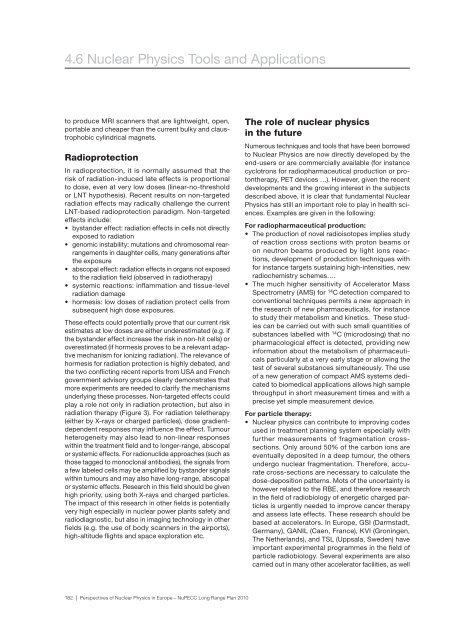Perspectives of Nuclear Physics in Europe - European Science ...
Perspectives of Nuclear Physics in Europe - European Science ...
Perspectives of Nuclear Physics in Europe - European Science ...
You also want an ePaper? Increase the reach of your titles
YUMPU automatically turns print PDFs into web optimized ePapers that Google loves.
4.6 <strong>Nuclear</strong> <strong>Physics</strong> Tools and Applications<br />
to produce MRI scanners that are lightweight, open,<br />
portable and cheaper than the current bulky and claustrophobic<br />
cyl<strong>in</strong>drical magnets.<br />
Radioprotection<br />
In radioprotection, it is normally assumed that the<br />
risk <strong>of</strong> radiation-<strong>in</strong>duced late effects is proportional<br />
to dose, even at very low doses (l<strong>in</strong>ear-no-threshold<br />
or LNT hypothesis). Recent results on non-targeted<br />
radiation effects may radically challenge the current<br />
LNT-based radioprotection paradigm. Non-targeted<br />
effects <strong>in</strong>clude:<br />
• bystander effect: radiation effects <strong>in</strong> cells not directly<br />
exposed to radiation<br />
• genomic <strong>in</strong>stability: mutations and chromosomal rearrangements<br />
<strong>in</strong> daughter cells, many generations after<br />
the exposure<br />
• abscopal effect: radiation effects <strong>in</strong> organs not exposed<br />
to the radiation field (observed <strong>in</strong> radiotherapy)<br />
• systemic reactions: <strong>in</strong>flammation and tissue-level<br />
radiation damage<br />
• hormesis: low doses <strong>of</strong> radiation protect cells from<br />
subsequent high dose exposures.<br />
These effects could potentially prove that our current risk<br />
estimates at low doses are either underestimated (e.g. if<br />
the bystander effect <strong>in</strong>crease the risk <strong>in</strong> non-hit cells) or<br />
overestimated (if hormesis proves to be a relevant adaptive<br />
mechanism for ioniz<strong>in</strong>g radiation). The relevance <strong>of</strong><br />
hormesis for radiation protection is highly debated, and<br />
the two conflict<strong>in</strong>g recent reports from USA and French<br />
government advisory groups clearly demonstrates that<br />
more experiments are needed to clarify the mechanisms<br />
underly<strong>in</strong>g these processes. Non-targeted effects could<br />
play a role not only <strong>in</strong> radiation protection, but also <strong>in</strong><br />
radiation therapy (Figure 3). For radiation teletherapy<br />
(either by X-rays or charged particles), dose gradientdependent<br />
responses may <strong>in</strong>fluence the effect. Tumour<br />
heterogeneity may also lead to non-l<strong>in</strong>ear responses<br />
with<strong>in</strong> the treatment field and to longer-range, abscopal<br />
or systemic effects. For radionuclide approaches (such as<br />
those tagged to monoclonal antibodies), the signals from<br />
a few labeled cells may be amplified by bystander signals<br />
with<strong>in</strong> tumours and may also have long-range, abscopal<br />
or systemic effects. Research <strong>in</strong> this field should be given<br />
high priority, us<strong>in</strong>g both X-rays and charged particles.<br />
The impact <strong>of</strong> this research <strong>in</strong> other fields is potentially<br />
very high especially <strong>in</strong> nuclear power plants safety and<br />
radiodiagnostic, but also <strong>in</strong> imag<strong>in</strong>g technology <strong>in</strong> other<br />
fields (e.g. the use <strong>of</strong> body scanners <strong>in</strong> the airports),<br />
high-altitude flights and space exploration etc.<br />
The role <strong>of</strong> nuclear physics<br />
<strong>in</strong> the future<br />
Numerous techniques and tools that have been borrowed<br />
to <strong>Nuclear</strong> <strong>Physics</strong> are now directly developed by the<br />
end-users or are commercially available (for <strong>in</strong>stance<br />
cyclotrons for radiopharmaceutical production or protontherapy,<br />
PET devices …). However, given the recent<br />
developments and the grow<strong>in</strong>g <strong>in</strong>terest <strong>in</strong> the subjects<br />
described above, it is clear that fundamental <strong>Nuclear</strong><br />
<strong>Physics</strong> has still an important role to play <strong>in</strong> health sciences.<br />
Examples are given <strong>in</strong> the follow<strong>in</strong>g:<br />
For radiopharmaceutical production:<br />
• The production <strong>of</strong> novel radioisotopes implies study<br />
<strong>of</strong> reaction cross sections with proton beams or<br />
on neutron beams produced by light ions reactions,<br />
development <strong>of</strong> production techniques with<br />
for <strong>in</strong>stance targets susta<strong>in</strong><strong>in</strong>g high-<strong>in</strong>tensities, new<br />
radiochemistry schemes….<br />
• The much higher sensitivity <strong>of</strong> Accelerator Mass<br />
Spectrometry (AMS) for 14 C detection compared to<br />
conventional techniques permits a new approach <strong>in</strong><br />
the research <strong>of</strong> new pharmaceuticals, for <strong>in</strong>stance<br />
to study their metabolism and k<strong>in</strong>etics. These studies<br />
can be carried out with such small quantities <strong>of</strong><br />
substances labelled with 14 C (microdos<strong>in</strong>g) that no<br />
pharmacological effect is detected, provid<strong>in</strong>g new<br />
<strong>in</strong>formation about the metabolism <strong>of</strong> pharmaceuticals<br />
particularly at a very early stage or allow<strong>in</strong>g the<br />
test <strong>of</strong> several substances simultaneously. The use<br />
<strong>of</strong> a new generation <strong>of</strong> compact AMS systems dedicated<br />
to biomedical applications allows high sample<br />
throughput <strong>in</strong> short measurement times and with a<br />
precise yet simple measurement device.<br />
For particle therapy:<br />
• <strong>Nuclear</strong> physics can contribute to improv<strong>in</strong>g codes<br />
used <strong>in</strong> treatment plann<strong>in</strong>g system especially with<br />
further measurements <strong>of</strong> fragmentation crosssections.<br />
Only around 50% <strong>of</strong> the carbon ions are<br />
eventually deposited <strong>in</strong> a deep tumour, the others<br />
undergo nuclear fragmentation. Therefore, accurate<br />
cross-sections are necessary to calculate the<br />
dose-deposition patterns. Mots <strong>of</strong> the uncerta<strong>in</strong>ty is<br />
however related to the RBE, and therefore research<br />
<strong>in</strong> the field <strong>of</strong> radiobiology <strong>of</strong> energetic charged particles<br />
is urgently needed to improve cancer therapy<br />
and assess late effects. These research should be<br />
based at accelerators. In <strong>Europe</strong>, GSI (Darmstadt,<br />
Germany), GANIL (Caen, France), KVI (Gron<strong>in</strong>gen,<br />
The Netherlands), and TSL (Uppsala, Sweden) have<br />
important experimental programmes <strong>in</strong> the field <strong>of</strong><br />
particle radiobiology. Several experiments are also<br />
carried out <strong>in</strong> many other accelerator facilities, as well<br />
182 | <strong>Perspectives</strong> <strong>of</strong> <strong>Nuclear</strong> <strong>Physics</strong> <strong>in</strong> <strong>Europe</strong> – NuPECC Long Range Plan 2010
















